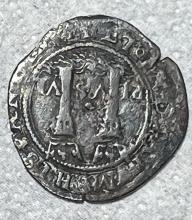medio tomin (Chav1)
This simplex glyph or notation stands for half of a tomin or real, two names for Spanish coins that were parts of pesos. This half tomin (or medio tomin, both loanwords in Nahuatl) is a circle that is filled in about half way, on the the viewer's left, and with the dividing line being vertical. A half of a tomin was one sixteenth (1/16) of a peso, perhaps the pay of half a day's labor for an agricultural worker in the middle of the Spanish colonial period.
Stephanie Wood
There were eight tomines or eight reales to each peso. These coins represent a European introduction in New Spain. A half tomin was a very small amount of money. See our Online Nahuatl Dictionary for more information about tomin coins and, as it evolved, "money." Given that the weight of coins (in gold or silver) was what determined their value, the term tomin could also refer to weight (12 granos, or grains).
Stephanie Wood
meo
medio
Stephanie Wood
1578
Jeff Haskett-Wood
monedas, tomines, reales, coins, money, dinero

medio, a half, https://nahuatl.wired-humanities.org/content/medio
tomin, a coin, worth one real, i.e., one eighth of a peso, https://nahuatl.wired-humanities.org/content/tomin
The Codex Chavero of Huexotzinco (or Códice Chavero de Huexotzinco), https://www.loc.gov/resource/gdcwdl.wdl_03246_001/?sp=1
The Codex Chavero of Huexotzinco (or Códice Chavero de Huexotzinco) is held by the Instituto Nacional de Antropología e Historia, México. It is published online by the World Digital Library and the Library of Congress, which is “unaware of any copyright or other restrictions in the World Digital Library Collection.”




